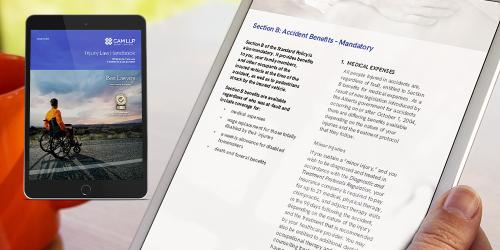What to know about Section B – Accidents Benefits (No-fault Benefits)
In Alberta, automobile insurance is prescribed by legislation. The result is a standardized insurance policy that is the same for all motorists. The three sections in Alberta’s Standard Owner’s Automobile Policy, Form (SPF No. 1) are:
- Section A – Third Party Liability Insurance – Mandatory
- Section B – Accident Benefits – Mandatory
- Section C – Loss of or damage to insured vehicle – Optional
If you’ve been involved in a motor-vehicle accident, you have a right to claim accident benefits from your insurer no matter who is at-fault in the accident. These benefits are often called Section B benefits, or “no-fault” benefits, and are mandatory benefits in an Alberta Standard Automobile Policy.
Section B can be confusing to read. Understanding your coverage and what benefits are available to you is a helpful first step in navigating a personal injury claim.
Who do Section B benefits cover?
Section B provides benefits to you, your family members, and other occupants of the insured vehicle at the time of a collision, and will also cover pedestrians and cyclists struck by the insured vehicle.
What’s covered in Section B?
Section B benefits allow for accident victims to access treatment for their injuries without having to wait for the outcome of a personal injury claim. As noted, you can access these benefits even if you are at-fault or partly at-fault for causing the accident that injured you.
The provisions under Section B, Subsection 1 – Medical Payments apply unless your injuries are of the type that fall under the Diagnostic and Treatment Protocols Regulation.
Section B benefits include coverage for:
- Reasonable medical expenses up to a maximum of $50,000 per person. There are also limits on expenses payable in relation to specific services
- Wage loss replacement for those totally and continuously disabled by their injuries
- A weekly allowance for people over 18 who are completely incapacitated, and not working, to help cover the costs of household duties
- Death, grief counseling, and funeral benefits
What medical expenses are covered and are there limits?
People injured in a car accident are entitled to Section B benefits for medical expenses. However, different benefits are available depending on the severity of your injuries and the treatment involved. In short, minor injuries are treated differently.
If you sustain a “minor injury,” and you wish to be treated in accordance with the Diagnostic and Treatment Protocols Regulation, your insurance company is required to pay for up to 21 medical, physical therapy, chiropractic, and adjunct therapy visits in the 90 days following the accident, depending on the injury and treatment recommended by your healthcare provider. You may also be entitled to additional dental, occupational therapy and psychological counseling treatments. However, if you need treatment more than 90 days after the accident, that treatment coverage will need to be approved by your insurance company.
If you suffer from a “serious injury,” medical benefits are available up to two years following the accident, up to a maximum of $50,000 per person involved in the accident. These medical benefits are also available should you choose not to be diagnosed and treated in accordance with the Diagnostic and Treatment Protocols Regulation.
Whether your injuries are minor or serious is a determination that should be made in consultation with your doctor and with reference to Alberta’s Minor Injury Regulation.
Any treatment that a doctor concludes is medically necessary should be covered. Expenses covered by Section B normally include, but are not limited to:
- Ambulance bills
- Prescriptions
- Physiotherapy
- Massage therapy (to a maximum of $350)
- Acupuncture (to a maximum of $350)
- Chiropractic care (to a maximum of $1,000)
- Psychological counseling
- Dental work
- Occupational therapy
Also, many Section B benefits are seen as “excess insurance.” This means that if you have other means of paying for treatment (i.e., public or private health care, coverage through work, etc) then those sources of coverage must be exhausted first before Section B benefits kick in.
What if You Can’t Work?
If you are injured in an accident, and you can’t work anytime within 60 days after the accident, you may qualify for Section B Total Disability Benefits to offset your loss of income. Note there is a seven day waiting period (i.e., wage loss benefits are not available in the first week after the accident). Benefits are available for a maximum of 104 weeks and the weekly benefit payable is 80% of your income or $600 per week, whichever is less. There are eligibility requirements to consider, but our team at CAM LLP can walk you through this process.
How do I qualify for total disability benefits?
There are criteria you must meet in order to qualify for disability benefits. To be eligible:
- You must have been employed at the time of the accident, or be at least 18 years of age and employed for six of the preceding twelve months.
- You must be wholly and continuously disabled from performing your job.
- Your insurance company will require your doctor to confirm your disability and your employer will need to confirm your employment details.
- Your insurer may choose to have you examined by a doctor of their choosing (called an Independent Medical Examination or IME) to confirm you are truly disabled.
What if you were unemployed at the time of your accident or you are a stay-at-home parent or homemaker?
If you are over 18 and not employed for wages or profit at the time of your injury, and you are unable to perform any of your household duties, you are eligible for benefits of $200/week for up to 104 weeks.
What benefits are available to families in the case of a fatal accident?
If the insured person is fatally injured in an accident, and they are a member of a household, death benefits are payable to their family. The amount can vary, as it depends on the deceased’s age and status in the household. Benefits are normally paid out to either the surviving head of the household or a surviving spouse.
Included in these benefits are a maximum of $6,150 for funeral expenses as well as $500/per family member for grief counseling expenses.
More information can be found in our post Fatal Accidents: Damages and Compensation for Wrongful Death of a Loved One.
Do your premiums go up if you use Section B benefits?
No. Section B benefits qualify as insurance coverage no matter who is at-fault, so using them will not affect your insurance rates.
Documents you need to submit to apply for Section B benefits and deadlines
Your insurance company will provide you with Notice and Proof of Claim forms to fill out, but keep in mind that you must notify the insurance company within 30 days of the accident. If it is not reasonable to inform the insurer within that time then you must do so as soon as practicable. To obtain Section B benefits you typically must:
- Complete Form AB-1 “Notice of Loss and Proof of Claim” and Form AB-1A “Claim for Disability Benefits” within 90 days of your accident.
- Have your healthcare practitioner complete Form AB-2 “Treatment Plan.”
- Give your insurance company written authorization to share your medical and insurance information to authenticate your claim.
Do you need a lawyer?
If you’ve been involved in an accident and your injuries don’t inhibit your daily life or your ability to work, you may opt to rely on your insurance company to walk you through the claim process. You can also reference our Injury Law Handbook, which reviews what to do if you’re involved in a car accident. Topics include, what to do at the scene of the accident, sources of compensation, and standard steps in your personal injury claim.
However, determining coverage and calculating benefit amounts can be complex and confusing. There may be issues regarding whether your injuries fall under the Diagnostic Treatment Protocols Regulation or “capped” by the amounts set out in the Minor Injury Regulation. There may also be disputes with your insurance company over coverage and entitlement to disability benefits. This is where having an experienced personal injury lawyer to guide you and deal with your insurance company on your behalf can be valuable. A lawyer will make sure that you are able to access all the benefits to which you are entitled. They will take the steps necessary to:
- Meet required application deadlines
- Prove your eligibility to recover medical costs
- Calculate earnings losses that have resulted from your accident
- Deal with insurance companies on your behalf if there are any disputes over coverage amounts.
When you are injured, your focus should be on doing what you need to do to recover. Having a lawyer to represent you in dealings with the insurance companies involved frees you up to do exactly that.
CAM LLP – Experienced Car Accident Injury Lawyers
We are here to help. We are always happy to talk to injured people about their claims whether they end up needing us or not. We believe in giving people all the information they need to make informed decisions about their options. Contact us for a free consultation.

